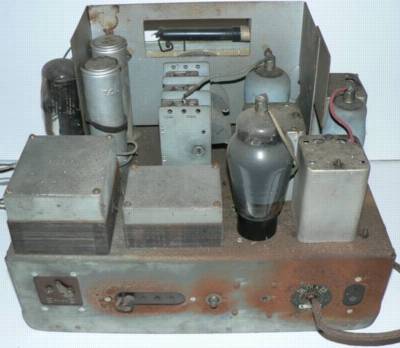

serial number 13656


Ultra model 25 AC mains operated console radio with Long and Medium wavebands and gramophone input housed in a veneered wooden cabinet. Valve line up: AC/TP, AC/VP1, AC/2Pen/DD and UU3 rectifier.This radio has a neon tuning indicator and below the knobs there is a pull out drawer with station details. Now working. The original cost of this the console model was £ 16 16s (16 guineas) UK early 1935. The "Service Engineer" supplement to "The Broadcaster" of June 1935 noted that "With only 4 valves, including rectifier, the Ultra 25 is an efficient 7 stage superhet". The output valve is a pentode combined with two diodes for LF and AVC. This (the console) model is equipped with a 10 inch energised loudspeaker.The frequency changer is a triode pentode fed by a bandpass tuning circuit.
This is one of three radios given to me by Mrs Vollmer, a friend of Mrs Nightingale the lady who gave me six other radios which belonged to her late husband. As can be seen they were all in a very sorry state and were destined for the tip.



Chassis as received


Front view and underside of chassis as received
The original wet electrolytic smoothing capacitors had failed and been replaced with a "Radiospares" modern replacement fitted to the large screening can for the coils and band changing switch. Several other components had also been replaced as can be seen in the view below. The first job was to check the mains transformer and the loudspeaker before deciding to progress further. So far so good, could the loudspeaker be rescued? The answer was yes, after quite a bit of fiddly work I managed to get the fine wire of the voice coil more or less straight and built up the damaged former with tissue paper and shellac varnish. Whilst this was setting the dents in the cone were reduced considerably by wetting it and allowing it to dry naturally. The chassis was given a clean and some of the rust was removed. After replacing the mains lead and dismantling the combined volume/on off switch for cleaning and repair I checked the other components and replaced where necessary. The set was then powered without the rectifier in place and nothing untoward happened the dial lights worked and the valve heaters glowed.


Chassis after cleaning and repair


The loudspeaker cone was badly dented and the voice coil was damaged though electrically intact

The loudspeaker cone was kept in place whilst being reassembled and the glue allowed to set with aluminium shims made from the neck of a screw top wine bottle.

Notice regarding patents on the rear cover

The radio now working and the tuning indicator glowing nicely
Soon after I had put all back together and prepared this web page back in 2007 something went bang inside, the tuning indicator ceased to glow and I switched it off. Six years later in 2013 I set about finding out what had gone wrong. The problem was soon apparent, the replacement 'Radiospares' electrolytic which had been fitted under the chassis in the 1960's had failed. As I only had axial tubular capacitors to hand I decided to open up the original cans and fit the modern replacements inside.I used a wood drill bit to open up the ends of both units to reveal the interior electrodes which were then removed with long nosed pliers.
The gramophone input to the radio is transformer coupled and I discovered that when connected to my iPod Touch the reproduction is really fine and noise free.


The radio is equipped with a pullout drawer rather like some old telephones. The card lists various European stations and their wavelengths. There is a note at the bottom indicating that replacement charts may be obtained from Ultra at their Chalk Farm Works, London NW3 or if after 1st May 1935 from their new factory in Western Avenue, Acton, London W3.

Reproduced below is part of a 1936 leaflet showing some of the radios and radiograms produced that year. The Ultra 26 (centre top) is electrically almost the same as the model 25 described above. The tuning indicator and the pick-up matching transformer have been omitted but the chassis layout and the valves used are the same.



